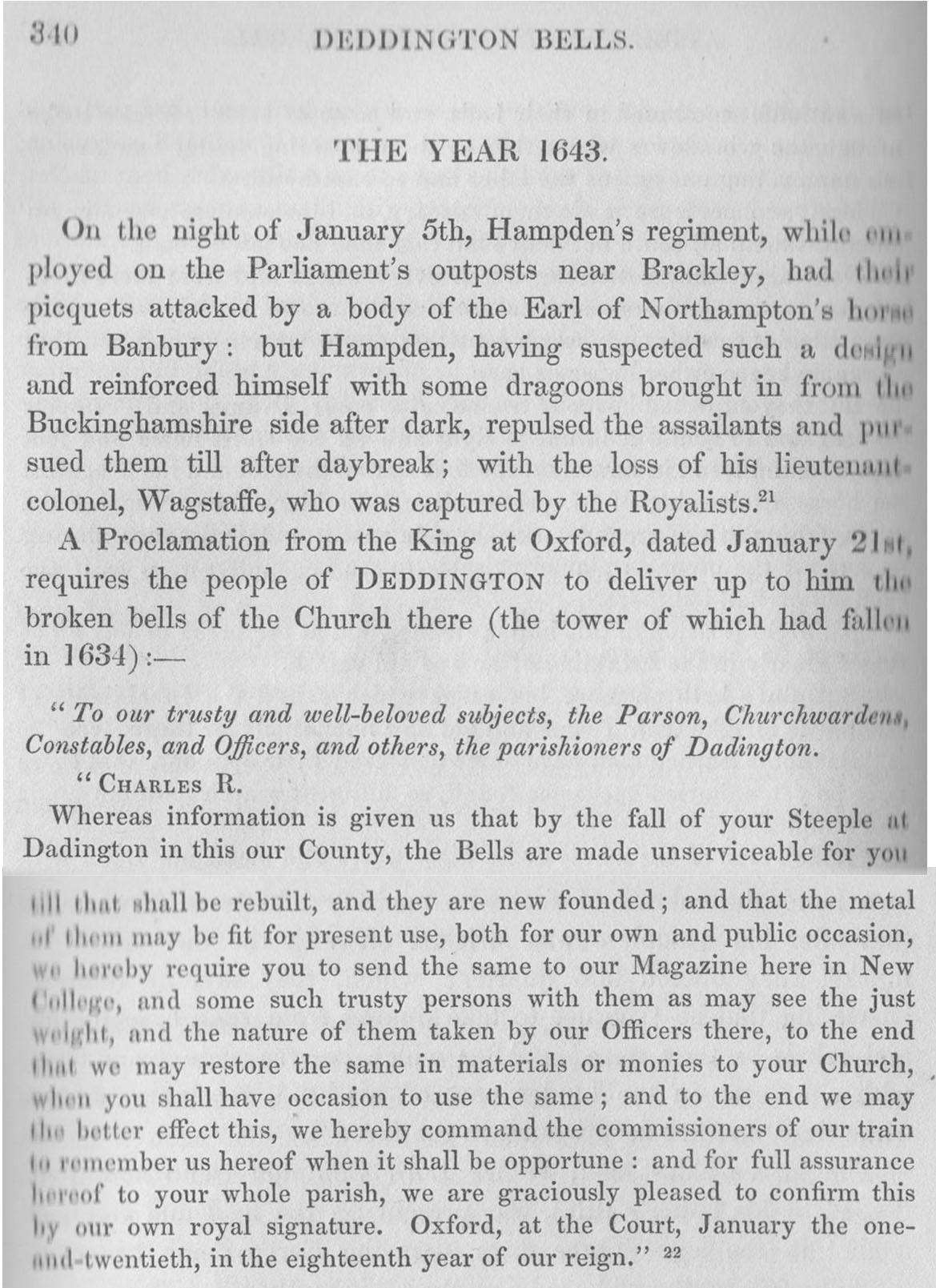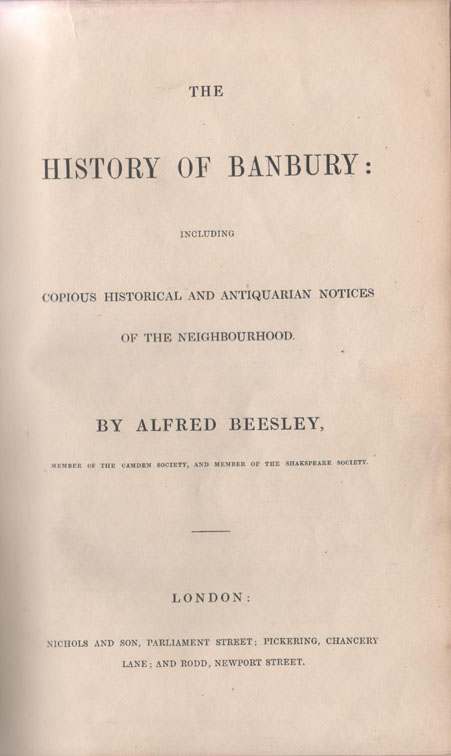Millennium Project
Rob Forsyth
On 22 August
1642 King Charles raised his Standard at Nottingham marking the start of
the First Civil War (1642-46) between Royalists and
Parliamentarians. The first pitched battle of the war was nearby at
Edgehill on 23 October 1642. It proved
inconclusive with both Royalists and Parliamentarians claiming victory.
A second skirmish at Turnham Green saw Charles forced to withdraw to
Oxford, which would serve as his base for the rest of the war. What
follows here is an account of Deddington's involvement in the
war as told by Alfred Beesley in his book (l) The History of Banbury (1841). Text in “quotes” is verbatim from the book with page numbers in brackets after (p…). The spelling of Deddington and other words is somewhat variable. Placed
as it was between Oxford and Banbury, Deddington saw a fairly constant
movement of both sides through what was then referred to as ‘a towne’.
It was witness to fighting on several occasions, had troops billeted on
it and the King stayed at the ‘Parsonage’ for the night of 1 July 1644. Anecdotally Parliamentarians and their horses were billeted in the church.Troops are believed to have sharpened their swords on a gravestone near the church door. click on images for larger versions
December 1642 Parliamentary forces occupied Banbury. They were driven out by Lord Northampton’s forces but then re-occupied the town and attempted to seize Banbury Castle. A letter from a Banbury man dated the 29 December carries on the story...“ And upon Thursday night they planted their great peece against the gate, but could not force it to make any entrance at all. In the meane time, my Lord of Northampton brought all the king’s strength of horse from Oxford, and came to Dedington, within foure [six] miles of Banbury, on Thursday night, where they lay all night in the field: which Northamptonshire men hearing and seeing they could not doe any good at the Castle, left the towne againe, and marched away about foure a clock in the morning with their ordnance, and the King’s men came in on Fryday, and quaild all the country over on Friday night, but returned towards Oxford againe in the morning; onely leaving some to keepe garrison in Banbury …” (p.332)
21 January 1643 A Proclamation from the King at Oxford "...requires the people of DEDDINGTON to deliver up to him the broken bells
of the church there (the tower of which had fallen in 1634)” (p.340) Click on the image (l) to read the full text of the proclamation
1 September 1643 Lord Essex [Parliamentary comander] and his force, which now numbered 15,000... “ took up his quarters at Aynho, and sent a regiment forward that night to DEDDINGTON, under the command of Colonel Middleton; who hearing of the two regiment’s of the King’s horse being there, first sent two companies of dragoons and a party of horse to approach the town. The King’s horse thereupon retreated to a passage towards Oxford, where Lord Wilmot was with fifty troops. The next morning, two Parliamentarian regiments, conducted by Colonel Middleton and Sir James Ramsay, advanced to that pass, where the enemy stood in two great bodies; and, after some skirmish, gained the pass, and placed dragoons to maintain it. The King’s forces, however, drew up again towards it, and a very hot skirmish ensued, which lasted many hours. At length the King’s troops made a retreat; but, perceiving that Colonel Middleton marched back towards the main army, they sent a party of horse to fall on his rear, who followed them through Deddington, but were beaten back through the town in some confusion.” (pp.351/352)
Lord Essex continued on his way and met the Royalists at the 1st Battle of Newbury on 21st September which was not a clear victory for either side.
1 July 1644 Following the Royalist victory at the Battle of Cropredy Bridge...
“Charles marched to Aynho; and then crossed the Cherwell lest Waller and Brown [Parliamentary commanders] might join their forces in the morning, and make it impossible for him to pass the river by falling on his rear and bringing him to battle under disadvantage. The army rested at Deddington that night, the King sleeping at ‘the Parsonage house’ there;* and thence proceeded on the next morning towards Evesham.” (pp.365/366)
* Another anecdotal story says he slept in Hempton. Victoria County History (fn.148) repeats Beesley's account.
24 August 1644 The Parliamentarians under the command of Col. John Fiennes laid siege to Banbury Castle – an event known as ‘The Great Siege of Banbury’. Lord Northampton raised the siege for the Royalists and we have the following Parliamentary account..."Monday, Oct. 28th You shall have a true relation of the raising of the siege at Banbury, being the substance and truth of the intelligence that is sent to my lord Generall and his army. ‘ A strong partee of horse and foot dragoons commanded by the Earle of Northampton and others, drawn out of the King’s army, and out of Oxford, were advance to Duddington (sic) four [six ] miles from Banbury on Thursday in the afternoon when our partee, that had followed a partee of theirs to Oxford, that gave us an alarme on Wednesday were scarcely come to their quarters. And though they were much wet and wearied by reason of their long march in pursuit of that partie, yet Colonel Fines drew them to Banbury wit all speed lest they should be fallen upon in their quarters, and our foot surprised.“ When they got to Banbury “..after due consideration of the enemies strength, it was concluded by all, that the siege should be raised…” (pp.381/382)
14 March 1645 “ Bennet Burroughs came yesterday from Banbury and said that the Earle of North’ton is there wth part of his Regiment the remaynder being quartered at Ano Doddington King's Sutton and Adderbury." (p.400)
January 1646 " At the time when the King's affairs began to wear an unfavourable aspect, the Royalist Cavalry were mostly drawn from Banbury for other service, and as early as January in this year, 1646, the seige of Banbury was renewed under the conduct of the celebrated Regicide, Colonel EDWARD WHALLEY, who in 1642, had been a cornet in John Fiennes's troop." (p.413)
"From Banbury Feb.22 it is certified, that the day before in the evening, the enemy [Royalists]from Woodstock had an intent to have faln upon our horse quarters at Deddington, but we (having intelligence in time) prevented them." (p.415)
" Articles agreed upon the 6 of May 1646,.... touching the surrender [of the castle} thereof." (p.419)
Deddington played no further part in the First Civil War which ended after two decisive engagements – the Battle of Naseby on 14 June and the Battle of Langport on 10 July – in which the Parliamentarians effectively destroyed Charles's armies. The King began to form an axis between Oxford and Newark-on-Trent in Nottinghamshire. He took Leicester but found his resources exhausted. In May 1646 he sought shelter with a Presbyterian Scottish army at Southwell in Nottinghamshire. The Scots eventually handed him over to the English Parliament. He was executed three years later on 30 January 1949.
Post Script - The 'Levellers'
The Levellers were a political movement during the Civil Wars committed to popular sovereignty, extended suffrage, equality before the law and religious tolerance. The hallmark of Leveller thought was its populism, as shown by its emphasis on equal natural rights, and their practice of reaching the public through pamphlets, petitions and vocal appeals to the crowd.
They came to prominence at the end of the First Civil War and were most influential before the start of the Second Civil War (1648–49). Their views and support were popular in the City of London and in some regiments in the New Model Army. Their ideas were presented in their manifesto "Agreement of the People". In contrast to the Diggers, the Levellers opposed common ownership, except in cases of mutual agreement of the property owners.
The final extract from Beesleys' book shows that Deddington, was at the forefront of free thinking "During the extinction of Monarchical power, the party called Levellers appeared in 1647, and subsequently in 1649." ........."The first mention that is made of them is in the early part of May, when letters from the governor of Oxford and other officers announced that the insurgents quartered about Derrington [Deddington] in parties of five to twenty in a place."
Acknowledgement
David Hood very kindly lent me his copy of Beesley’s book which had formerly belonged to John Cheney.
